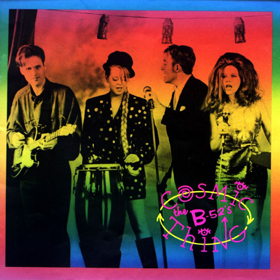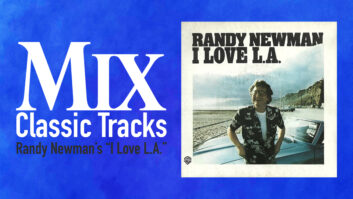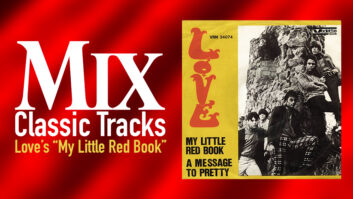Weddings, bar mitzvahs, backyard barbecues… it just wouldn’t be a party without “Love Shack,” The B-52s’ campy, happy dance song from their 1989 album Cosmic Thing. It’s become the alternative, tongue-in-cheek equivalent of Kool & The Gang’s “Celebration.” It’s odd to think that this monster hit was sort of an afterthought.
By all accounts, the members of the B-52s were feeling somewhat fragile when they reunited to make Cosmic Thing, the follow-up to Bouncing Off the Satellites. The group that hit big with their off-the-wall approach to groovy dance/surf punk had scored mega-hits in the late ’70s and early ’80s with songs like “Private Idaho,” “Planet Claire” and, of course, “Rock Lobster.” Built on the band’s funky experimental sounds, their first four albums all made it to Billboard’s Top 40.

However, as is well-known, guitarist Ricky Wilson—brother of vocalist Cindy Wilson—was doing his best to mask his decline as he suffered from HIV/AIDS during the recording of the band’s fifth record, Bouncing Off the Satellites. He passed away during the sessions. In the few years that followed Ricky Wilson’s death, the band took a hiatus and debated whether to re-form. But after taking a little time, drummer Keith Strickland took on the guitarist’s role and began working on new material. By summer 1988, original vocalists Cindy Wilson, Kate Pierson and Fred Schneider, as well as now-guitarist Strickland, were ready to make the next B-52s album.
The band split Cosmic Thing between two musician/producers, recording half of the songs with Nile Rodgers and another handful with Don Was, who says he had come to love The B-52s back in Detroit, where he began his career and where he recalls The B-52s were considered an R&B group. “So, the fact that they called me must have had something to do with Was (Not Was), and us being white people who made this dance/party music that wasn’t disco,” Was says. “Whatever reason they called me, I was thrilled to do it.”
The band sent Was demos of four of the songs they wanted him to produce. “But ‘Love Shack’ was not included,” he says. “It was ‘Bushfire,’ ‘Dry County,’ ‘Junebug’ and ‘Channel Z.’”
Was traveled to Woodstock, N.Y., where the band went into a few days of pre-production/rehearsals in a barn on the property of Bearsville Studios. Then they moved to Dreamland Studios, also in Woodstock, to record. “We had booked seven days in that studio, and everything went so smoothly with those three songs that we had an extra day before we were going to break down and do overdubs,” Was recalls. “That’s when they said, ‘Well, we’ve got this other song, and as long as we’re set up, we could try it. But it’s 12 minutes long and we don’t know what to make of it.’
“Now, the way they write songs, they would just jam on a groove, and they would sing stream-of-consciousness riffs; a lot of it would be unremarkable, but some of it would be amazing,” Was continues. “And when someone said something amazing, they’d write it down on a piece of yellow legal paper and tape it to the wall. They’d start at the ceiling, and when they got down to the floor, they’d figure, ‘We must have a song.’ It was all disjointed stuff, a little like George Clinton: ‘Free your mind and your ass will follow’—that kind of thing.”
Was took the band members out on the lawn outside Dreamland, where they spread out all of those pieces of paper. “It started as this disconnected thing on a groove that was just like ‘Cool Jerk,’” Was says. “We untaped the pages, and I guess it took someone objective to say, ‘Well, it looks like this is about…a love shack. And maybe this thing that you have in here once—‘The love shack is a little old place where we can get together’—maybe that’s the chorus. Most of those yellow pages had nothing to do with the love shack, but once we had that form, we cut it down to four or five minutes.”
So, with their extra day, the band went back to work, recording the song that had become “Love Shack,” with Was and Dreamland’s then-chief engineer Dave Cook.
“The process for recording ‘Love Shack’ was the same as it had been for the other tracks we recorded,” Cook says. “In the big room, which used to be a church, we had [Charley Drayton’s] drums. Keith’s guitar amp was in an iso booth along with Sara Lee’s bass amp. We put the three singers in a smaller room off the main room that the control room looked directly into; it had a small booth that Fred was in by himself, peering through a very small window, which looked kind of amusing, and we built booths for the girls out of gobos. They were somewhat cramped, but we wanted to isolate them as much as possible and still be able to cut all three vocals live.”
All of the Was-produced tracks were recorded analog, to a Studer A80 machine, using the studio’s early ’70s vintage API console. “I used Neumann U 87s on all of the vocals,” Cook recalls. “All the preamps were on board, in the console. I used a couple of Pultecs on drums, and probably dbx 160s on their vocals; [Shure SM] 57s on guitar amps and a Neumann U 47 fet on the bass amp, as well as a DI. The biggest challenge was to get the vocals isolated so we could get all the punches we needed. Later we would do doubles and fixes, and add the horns. I remember we listened very quietly on Auratones while doing vocals. Don was very focused on the vocals, and he heard pitch best when he listened quietly on small speakers. It is a method I’ve used myself ever since.”
All of the basic tracks were live, full takes, of which there were many—to the point where the band almost gave up on the song. “The first take was great, but when it started to kick back into that ‘Love shack, baby love shack’ part, it fell apart,” Was says. “So we went for take two, take three. It got up to take 25, and every take felt worse. We knew it better, but it lacked spirit. We went to dinner really bummed, but we said, ‘The first take felt great, right? It just fell apart at the end.’ We went back and listened, and it was amazing. It had spirit that none of the other takes had, and that’s when it occurred to us: Why don’t we just punch everything in after ‘Your tin roof—rusted.’ All we have to do is get the ending right. I don’t know why we hadn’t thought of that, but it wasn’t the sort of thing you did as much then. With Pro Tools, everyone approaches a song like this thing with little modular pieces, but back then we didn’t think of it that way; it was a performance.”
Cook says that the mood in the studio was professional and generally pretty upbeat, except for Cindy Wilson. “I remember her being pretty down for a lot of the process,” Cook says. “I would look at her, thinking, ‘Wow, this must be really tough on her.’”
“You can hear it in that ‘Tin roof—rusted’ thing,” Was says. “Cindy got very emotional. It was like in 12 seconds she went from extreme glee to really depressed about that roof rusting. The intensity of what she did was startling.”
That show of feeling may have been difficult for the band to follow, but it ended up being one of the most memorable bits of the song, and that line seems to have its own little spotlight in the final track, which was mixed by Rodgers’ engineer, Tom Durack. Durack mixed the Rodgers-produced tracks on the SSL 4000E at Skyline Studios (New York City), where he and Rodgers worked regularly, but when he began working on Was’ tracks, that room wasn’t available, so he took a couple of songs to Electric Lady. The first song he mixed there was “Love Shack.”
“I remember finding [Dave Cook’s recordings] easier to mix than the tracks I had recorded,” Durack says, “probably mostly because I came to them with fresh ears. But Dave Cook’s tracks were really well-recorded, and when the arrangement and performances are really right as well, a song can sometimes almost mix itself. I also remember being very happy with the sound of the room tracks from Dreamland, and making a lot of use of them in the drum sound.
Classic Tracks: Eddie Cochran’s “Summertime Blues”
“I’m always struck when I hear it, how dry a mix for its time ‘Love Shack’ is,” Durack continues. “The drum ambiance is just the Dreamland room, compressed. There may be a little EMT 140, too, elsewhere in the mix, but the ambiance you hear on Kate’s, Cindy’s and Fred’s vocals—as well as Keith’s guitar solo—are mostly just short delays, which I probably worked up with Lexicon PCM 42s and/or 41s, perhaps an AMS DMX15-80 as well.”
Durack listened mainly on Auratones and Yamaha NS-10s. He worked in Studio B—also fitted with an SSL console—but he says that his strongest memory of that session has nothing to do with technology. “I’ve never forgotten this. I got to the studio early and set up the mix, and Kate Pierson was the first member of the band to arrive. She comes into the control room just beaming, and asks me, ‘Do you realize where we are?’ And I said, ‘Yeah, this is Electric Lady.’ And she said, ‘Yeah, but do you realize where we are? We are in Studio B at 52 West 8th Street.’ We took that to be an excellent omen.”
Omen or not, Cosmic Thing brought The B-52s back to the top of the charts; the album reached Number 4 on the U.S. album chart in 1989, partly on the strength of the Number 2 single “Love Shack.” “It’s the biggest single I’ve ever been involved with,” Was says. “It was a life changer for everybody involved.”
Was went straight from Cosmic Thing to producing Bonnie Raitt’s Grammy-winning Nick of Time; those two releases combined made him one of the most in-demand producers in the business. Cook and Durack both launched freelance engineering careers. Durack does a lot of mixing and mastering in his personal studio, and Cook owns and operates AREA 52 Studios in Saugerties, N.Y.; he combines his recording work there with touring as FOH engineer with Laurie Anderson, Medeski Martin & Wood, Natalie Merchant and others.
Meanwhile, The B-52s continue to be part of everyone’s party soundtrack. They’re on tour this summer, co-headlining many dates with Squeeze, and PBS has been airing a concert special celebrating the band’s 35th anniversary.







